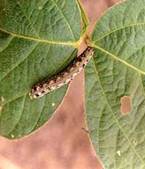| Tobacco caterpillar: Spodoptera litura |
Symptoms of damage
- Larvae feed on the chlorophyll of the leaves.
- The eaten leaves give the appearance of whitish yellow web.
|
Identification of the pest
- Egg: Egg masses appear golden brown.
- Larva: Pale greenish with dark markings. Gregarious in the early stages
Adult
- Forewings: Brown colour with wavy white marking
- Hind wings: White colour with a brown patch along the margin
|
 |
 |
Larva |
Adult |
|
Management
- Deep summer ploughing.
- Avoid pre-monsoon sowing.
- Optimum seed rate (70-100 kg/ha) should be used.
- Collect and destroy infested plant parts, egg masses and larva.
- Install sex pheromone trap @ 10 traps/ha for early deduction of the pest.
- Erection of bird perches @ 10-12/ha.
- Field Sanitation: Remove the infested plant parts at least once in 10 days and bury them in compost pit to monitor and reduce the populations of tobacco caterpillar. Traps are used for monitoring the pest situation.
- Install one light trap (200W mercury vapour lamp) per hectare to catch the adults of some nocturnal pests such as tobacco caterpillar (positively phototropic).
- Install five sex pheromone traps per hectare (change septa after 3 weeks), specific for male adults of tobacco caterpillar (separate pheromone for each).
- Apply Profenophos 50 % EC @ 1000 ml/ha or deltarnethrin 2.8 EC @ 750 ml/ha
or quinolphos 25 EC @ 1000ml/ha
- In case of severe infestation apply polytrin 44% @ 1 lit/ha
or profenophos 50 EC 2.00 lit/ha
- Dust Deltamethrin 2.8% EC or quinalphos 1.5% @ 25kg/ha when their population is likely to reach 10/m row length (ETL). Repeat it as needed.
|


